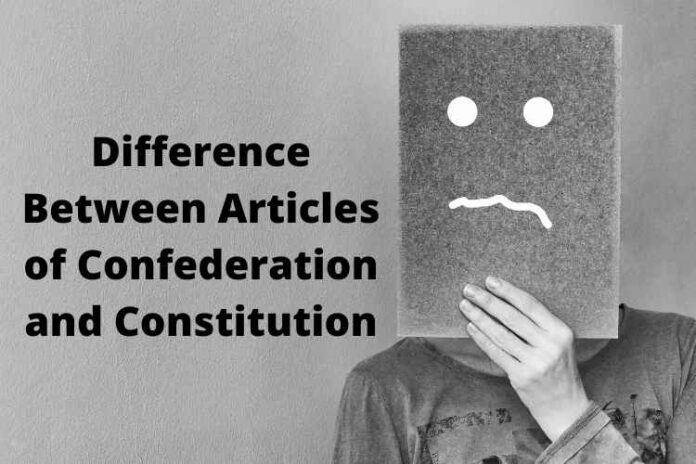The Articles of Confederation and the Constitution are two documents that reflect the changes brought about by the American Revolution. The 13 states of the United States of America accepted and signed the Articles of Confederation’s regulations. A constitution enumerates all of the norms and principles that a democratic government must adhere to.
The 13 states of the United States pledged to follow the Articles of confederation and the Perpetual Union. This is thought to be their first constitution. On November 15, 1777, the Second Continental Congress authorized it. It was enacted on March 1, 1781, to establish state independence and sovereignty. While A constitution is a compilation of all the concepts, laws, and regulations that the government and citizens of a country must adhere to. It is a democratic country’s backbone. India’s Constitution is the world’s longest, with 444 articles, making it the world’s largest democracy.
In this article, we are going to discuss the meaning, comparisons, and difference between Articles of Confederation and the Constitution.
About Articles of Confederation
The Perpetual Union and the Articles of Confederation were a bond signed by 13 states in the United State of America. It was made up of the rules that these states had to obey in the 18th century. It was the first agreement for a central government that was weak. The Articles of Confederation were written agreements that elaborated on the concept of establishing a friendly relationship between the states. This was a lengthy procedure. The paper was accepted by the people after several talks and reorganization. The major goal of the system was to distribute power evenly among all of the states.
The documents were finalized by a group of 13 members. The committee’s chairman, John Dickinson, presented the final document of the Articles of Confederation on July 12, 1776. Even after the final treaty was presented, there were disagreements about the division of authority among the states. In the early 1779s, Virginia became the first state to ratify the Articles of Confederation, followed by the other states. However, these articles gave the central government the bare minimum of power, resulting in an unstructured central government. As a result, the government could not accept this solution.
About Constitution
A country’s constitution is a collection of all the laws and regulations that citizens must follow in the country. This is created by a group of persons the government trusts because of their societal knowledge. This text established the rules by which a country or entity should b governed. This is a written document in which the principles are prepared with the entity’s behavior in mind. A codified constitution is one in which the entire constitution is written in one document. An uncodified constitution is one in which the constitution is written in the form of Acts. The United Kingdom’s constitution has not been codified.
Anyone who wants a well-organized and systematic working environment can draft a constitution. Because a democratic country’s constitution is its backbone, power is shared among various departments. They also describe how much authority the majority, minority, and individuals have. The central government is regarded as the peak of power under the constitution. The federal government has the authority to decide whether or not the laws enacted by the state governments are valid. In addition, the constitution recognized an individual citizen as a power carrier. Individual votes determine how the government is formed.
RELATED – DIFFERENCE BETWEEN ESPORTS AND SPORTS: DO YOU KNOW THE MAJOR DIFFERENCES?
Articles of Confederation Vs Constitution (Differences)
• According to the Articles of Confederation, all states enjoyed equal power. The constitution split the powers among the several departments. The central government, on the other hand, wields ultimate power.
• According to the Articles of Confederation, individual citizens were not allowed to claim the Bill of Rights. According to the constitution, anybody can assert their rights.
• The articles of Confederation utilize a unicameral system, whereas the constitution uses a bicameral system with two chambers in the legislature.
• According to the Article of Confederation, each state has a single vote, but under the Constitution, every legislative member has a vote in the legislature.
• The Articles of Confederation compelled a bill to be passed if 9 out of 13 states agreed to it. The constitution stipulates that a law must be passed by both chambers before it can be enforced on the people.
Other Comparison
| Parameter of Comparison | Articles of Confederation | Constitution |
| Voting Power | According to the Article of Confederation, each state had a single vote. | According to the Constitution, each legislative representative has one vote in parliament. |
| Bill of rights | Under the Articles of Confederation, citizens could not claim the Bill of Rights. | Because the Constitution treats everyone equally, citizens can assert their rights under the Bill of Right. |
| Distribution of Power | The Articles of Confederation divided power among several unions. | The Constitution share power among subordinates, but the central authority retains ultimate control. |
| Codification of Law | It followed the principle of unicameralism, in which the parliament is divided into single chamber. | The constitution is based on bicameralism, which means that the legislature is divided into two chambers. |
| Law enforcement | The law should have been supported by 9 out of 13 states in order for it to be enforced everywhere. | To alter a legislation in a country, both houses of parliament must support it. |
RELATED – Difference Between Catholic Witness And Jehovah Witness
Conclusion
The Articles of Confederation and the Constitution are two documents that reflect the changes brought about by the American Revolution. The 13 states of the United States of America accepted and signed the Articles of Confederation’s regulations. A constitution enumerates all of the norms and principles that a democratic government must adhere to. According to the Articles of Confederation, individual citizens were not allowed to claim the Bill of Rights. According to the constitution, anybody can assert their rights. In last, I hope this blog is sufficient enough to clarify the Difference Between Articles of Confederation and Constitution.






















